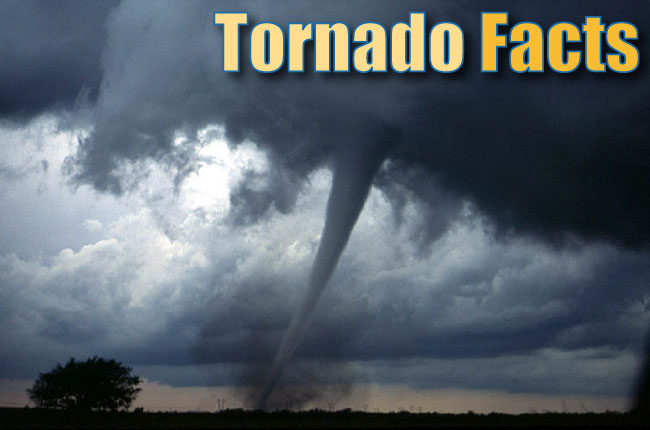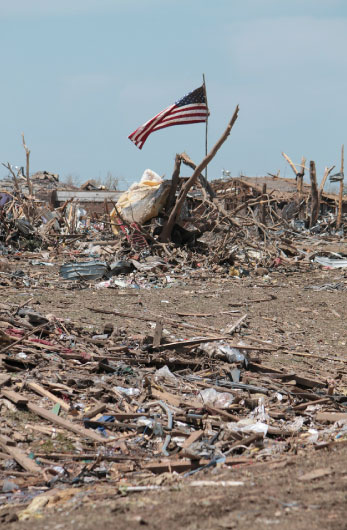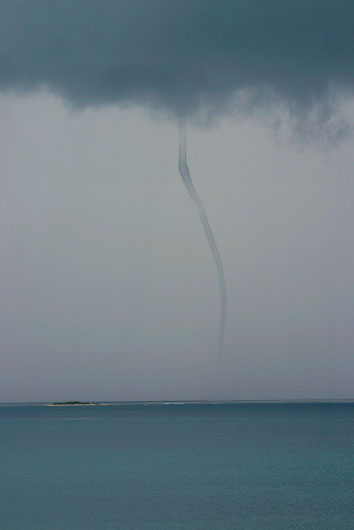Tornadoes
A tornado is a very strong wind that spins around at high speed. Tornadoes travel quickly over the land causing a great deal of destruction. They are powerful and dangerous... and therefore very exciting! Er, I mean, for scientists they're very interesting!
Here are some more awesome tornado facts for kids...
(Part of our Science Articles series.)
Introduction: Picture A Tornado
Hailstones are battering the windows and you hear the distant rumble of thunder. A storm is approaching!
In the distance you see something strange. It's like a big grey cloud stretching from the ground up into the sky.
The hailstones suddenly stop.
The skies darken and the wind gets stronger and stronger. You realize that the thing that you can see is a tornado... and it’s coming straight towards you!
You can sense just how powerful the tornado is, even though it's still quite a long way away. Leaves and twigs are flying around, and the garden gate is squeaking as it blows open and shut.
The tornado moves over the ground, lifting things up and throwing them into the air.
As you watch, the tornado uproots a tree, then drags a car along the ground before throwing it onto its roof.
The trees near you are being bent over and their branches are breaking under the strain. A man runs down the street and can barely stay on his feet.
All you can hear is the howling wind!
Luckily, it looks like the tornado is going to miss your town, but you still climb down into the safety of your storm shelter – just in case!
Tornado Facts For Kids
A tornado is a strong, spinning wind that forms a column from a cloud to the ground. Tornadoes look like giant, grey, funnel-shaped clouds.
Tornadoes can travel long distances. Some have been known to travel over 200 miles. However, the average distance travelled by a tornado in the United States is 5 miles.
Because wind is invisible, it’s actually water droplets, as well as the dust and everything else being blown around, that gives a tornado its grey colour.
Tornadoes make continuous rumbling and roaring sounds. They can be heard 40 kilometres away.
How Big Are Tornadoes?
Tornadoes vary in size, ranging from around 250 feet (76 m) across, to more than two miles (3.2 km) across.
How Powerful Are Tornadoes?
A tornado’s wind can blow from 110 miles per hour (177 km/h), to an incredible 300 miles per hour (483 km/h)!
The strength of a tornado is gauged using the Enhanced Fujita Scale. A tornado is rated from 0 to 5 based on the amount of damage it has caused to structures and vegetation. Therefore, a tornado rated EF5 is the strongest tornado there is!
How Are Tornadoes Formed?
Tornadoes appear during thunderstorms when the atmospheric conditions are just right (or just wrong, depending on which way you look at it!) Scientists still don’t know exactly what causes tornadoes, and why some storms produce tornadoes and some don’t.
Where Do You Get Tornadoes?
Tornadoes have occurred in every continent apart from Antarctica. Although tornadoes occur in most places in the world, they are most common in North America.
Tornadoes are most likely to occur in the ‘Tornado Alley’ region of the United States.
Tornado Alley States
Tornado Alley is the nickname given to an area that includes northern Texas, Oklahoma, Kansas, and Nebraska.
Storm Chasers
Some people actually try to get close to tornadoes! They are called storm chasers. When they hear that a tornado is in progress, they drive there as fast as they can. Some storm chasers take photographs or film the tornado. Some collect scientific data. Others just enjoy being close to such an amazing storm, even if it is dangerous!
Would you like to be a storm chaser?
Other Types Of Tornado
There are other types of tornado. A landspout is a smaller, less powerful kind of tornado that grows upwards from the ground. They look like giant tubes.
Waterspouts are spinning columns of air that occur over water, rather than over land. Some are simply tornadoes that have formed over water, others are more like landspouts, in that they grow upwards from the surface of the water.
10 Facts About Tornadoes
- A tornado is a very strong spinning wind that forms during a storm. A column of air forms from a storm cloud down to the ground. Tornadoes can be very destructive, pulling things from the ground and throwing them around.
- Water droplets, formed in the tornado, together with dust and other things the tornado has picked up, give the tornado a grey colour.
- Tornadoes are also known as ‘twisters’.
- Tornadoes can be over two miles across!
- Tornadoes can travel over 200 miles, but most travel around 5 miles.
- A tornado's strength is rated from 0 to 5 on the Enhanced Fujita Scale. This scale is based on the amount of destruction a tornado has caused. Therefore, a tornado rated EF5 is the strongest tornado there is.
- Other types of tornado include landspouts and waterspouts.
- There are people known as ‘storm chasers’ who deliberately follow tornadoes! They do this to take photographs or films, to collect scientific data or just because they enjoy the danger!
- Tornadoes occur most frequently in the United States. Part of the USA has even been given the nickname ‘Tornado Alley’ because of the large amount of tornadoes experienced in the region.
- Tornadoes are very loud. They make a continuous rumbling or roaring sound, and can be heard over 40 kilometres away.
Tornado Activities
Tornadoes are amazing things. Although they can be very dangerous, they are also very beautiful. Why don’t you try these tornado activities?
- Imagine that you can see a tornado passing close by. Try to picture the scene, and think about the noises you would hear. Write a short story about how you save someone from a tornado.
- Draw an EF5 tornado (the strongest type of tornado). Be sure to include lots of destruction!
- Imagine that you are a storm chaser. What would you take with you to record the storm? How would you stay safe? How would you share your pictures, films and writing? Could your research be used to help people learn more about tornadoes?
We hope that you enjoyed these tornado facts for kids! Read more articles and learn more about science and nature!
See more science articles here.






